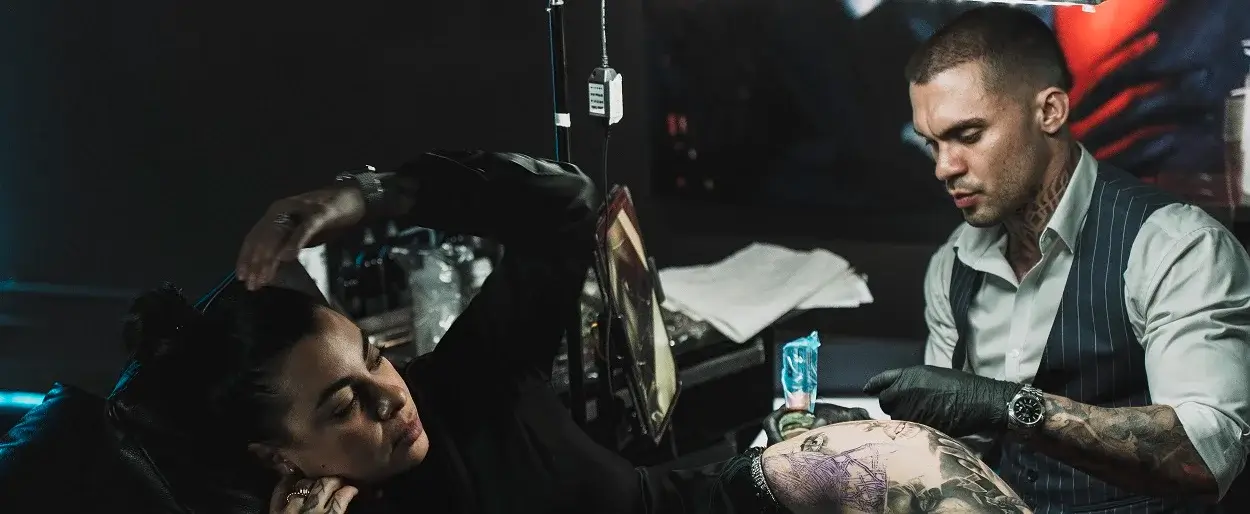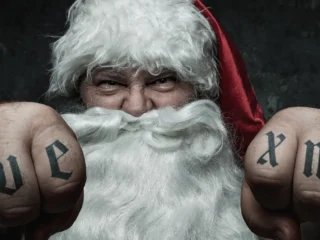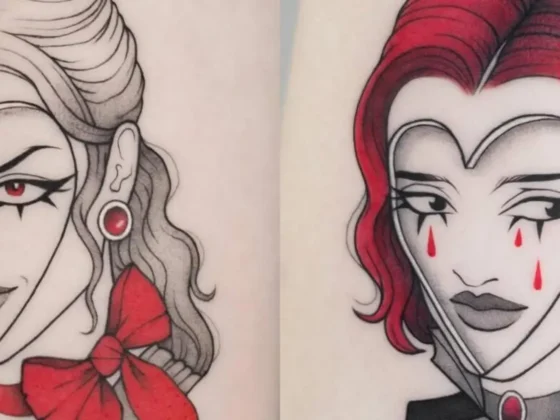Inked Mag Staff
December 6th, 2019
Jidenna: A Warrior’s Way
The "Classic Man" shares his truth
Interview by Dove Clark
When Jidenna sprung on to the music scene in 2015 with his breakaway hit “Classic Man,” he caught the world’s attention with his dashing good looks and buttoned-up style. While the song was part of Janelle Monet’s Wondaland imprint EP “The Eephus,” the single catapulted Jidenna into a spotlight that left fans wanting more. So little was known about the energetic performer, and it has taken some years to unravel the mystery.
Born in Wisconsin, Jidenna lived part of his childhood in Nigeria, and his family moved back to the U.S. to settle in Massachusetts. A graduate of Stanford University, Jidenna built up his personal style by fusing influences from American Hip Hop and Nigerian culture. As an adult, he is well-traveled, and is a true student of the world. By the time his official first album “The Chief “was released in 2017, we got a sense of how Jidenna was able to effortlessly weave his knowledge into the music in soulful, resonating ways.

This Summer, Jidenna dropped his second full-length solo album, “85 to Africa,” via Wondaland and Epic Records. His song “Sufi Woman” had longtime fans going gaga, while numerous critics took him to task for incorporating too many messages into the project.
We sat down with Jidenna to get his thoughts on the critic’s views, what he wants fans to take away from his messages and much more. And how did he sit through receiving a tattoo for over a full day?!
How do you feel about the critique you’ve received from music journalists that you’re not prepared to deliver deep messages through your music? Do you feel you’re prepared?
I’m definitely ready. I’ve studied for years. The ideas I have don’t come in overnight and in one album cycle. They don’t come in two years. They come over decades, and I’ve lived over decades. Since a boy, I’ve lived as a person amongst different neighborhoods. The neighborhoods I talk about. So absolutely! [laughs] I feel more than prepared. If I wasn’t, I wouldn’t open my mouth. I was a quiet boy, shy and reserved. Now I’m speaking.
How do you feel about people labeling you or your music on any level?And the fact that you’ve incorporated all these sounds and styles based on your travels, yet some people are shocked by that?
I don’t know why people are shocked because… one, my heritage. I’m from Nigeria. When my cousins hear something new that’s fresh from London or Lagos, I’m getting that in real time. That allowed me to do records early on even before “Classic Man;” then to release songs after “Classic Man” like “Little Bit More” where I’m speaking pidgin English in the song. There’s nobody on American radio probably in history that was using the word wahala, which means worries or trouble like “No Wahala.” At the end of the riddims in that, the remix with Burna Boy, I saw early. So they can just check the records and the records will show.

As far as labels, I don’t mind labels. I know a lot of artists are like “Don’t put me in a box,” and I get that. Obviously, I felt that way with the “Classic Man” image. Even though it was real for me, when it got blown up to the world it became almost like a caricature. I feel a lot freer now to show other sides of me. As far as labels, I’m cool with all the genres, I don’t care. Artists say that “I don’t want to be labeled” and they wear all three brand names on themselves. That’s so funny to me. On one hand you don’t wanna be labeled, but then you wear labels.
To me, the great artists weren’t afraid of the label. Not the record label, but labels. They knew what they were doing. If you look at Prince, his style in fashion and his performance. If I was to make an equation style wise, JimI Hendrix plus James Brown equals Prince. Lady Gaga was clear. Like Avant Garde plus Madonna equals Lady Gaga. There are always equations and that makes it easy. Rae Sremmurd equals trap’s Kris Kross. This is all style wise. Initially, it allows people to digest you.
What do you want people to know most about you through this album?
I care less about people knowing about me honestly, period. I’m here to just relay a specific message, that’s it. As long as that message comes out, I’m good.
So that message is important to you?
Yeah, it means something to me because it’s coming through me for a large group of people that will affect the largest group of people we call humanity. When I was 10 years old, my best friend at the time’s father delivered papers. His son, my best friend, was the assistant and he became the paper boy eventually. We used to roll around and drive in this broke down white Dodge Caravan. I would roll with them and deliver papers; grab the money from the little manila folders and took the paper out just for fun. It was important that the papers got delivered on time. It was important that those subscribers got the messages in their morning paper. That’s how I feel. I don’t feel like I need you to know everything about me and “wow my life is so cool and important.”
I love my life. I love it, but I’m here to deliver the paper, and the paper right now says “85 to Africa.” The paper right now says this highway must be built and it has to be a real highway. To be clear, what the highway means is a cultural and economic connection between the diaspora and the homeland. I think every human being can relate to that because most of us do not live where our families down the line were originally from. Especially in this county, it’s literally 99%. Or like when your child goes out to school or a new place, the idea of returning home is a universal theme of humanity.

Let’s talk about your ink. You have a very intense sleeve. What is the meaning behind it?
On my chest and shoulder, the ancient writing system called Nsibidi is written here. My good friend Josh [Elsas] from Island Tattoo inscribed it. I studied it, he studied it as well, and it’s from south eastern Nigeria. The reason I was inspired to get it was because black people have been told for a long time by ourselves and by other people that we only had oral tradition. We spoke and that’s why we’re good orators. It’s great, it’s a nice story. It makes you feel good about being a speaker or good with music, but it’s not true. We had different writing systems, and it wasn’t just the hieroglyphs. That’s from one region. Africa’s a huge space. If you really look back, you find writing systems across Africa, but one of the oldest is in Nsibidi. The oldest in West Africa was definitely that. Currently they date it to 2000 B.C. It may even go back to 5000 B.C. If they do certify those stones, that means it is as old as the hieroglyphics. That’s West Africa. That’s where most African Americans and Caribbean Americans who were enslaved are from. It’s very important.
Once I found that out, I was like, “I’m going to ink that on my body so that I am a living example of that. Also, [so] that I never forget it and anyone that looks at me never forgets that we have one.” I studied the characters, then Josh studied the characters and listened to my story for like six hours after having researched me and my family weeks before. We wrote the symbol “EZE” and it means high chief or higher chief. Some people translate it as a king, but it’s just a higher chief or chief. Higuey is chief, Eze is high chief.
And then it says “unifies the people, creates prosperity for the people.” “Using music” which is the symbol on my shoulder and then this is like a bull mask, I’m a Taurus. And these are the ancestors lifting up the message in the music. That’s the message, this high chief comes and unifies prosperity among the people using music that’s coming from the ancestors and he has a strong Taurus bloodline. My father was a Taurus. My grandfather was a Taurus. My niece is a Taurus. My brother’s a Taurus. My other grandfather was a Taurus. I just have a lot of Taurus blood. When my father passed there were 12 bulls that walked across the dirt road in the village where we buried him right after we buried. That’s the ancient modern day Nigerian symbol. The rest are Polynesian symbols. Josh is Hawaiian, and he inked the Hawaiian king’s face tattoo. So if you ever see the king of Hawaii his face was done by the same guy who did this. Also Ray Lewis the football player, same tattoo artist. Those are some of the more notable figures.

These symbols are different forms of spears and leaves. They’re all armor essentially. I told him I needed a lot of armor for what I was trying to do. He put different symbols that meant armor and he sensed this would be me peeling back the layers of the shell. This is the symbol of the crab peeling back the layers surrounded by all this armor here. That’s essentially the tattoo in a nutshell.
How many hours did that take?
Twenty-six. About six hours of planning, so it’s 32. And we did it in two days back to back. He went in so he did like 12 or 13 hours per day. I took a nap in between.
How much did it hurt to sit through that for two days?
It was terrible. I was in shock. That was the longest tattoo in technically two sittings, or two for one stretch. He’s never done it for that long in his life and he’s been tattooing for 25 years. He was like “I’ve never seen somebody sit like that.” For me it was like a rite of passage, it was my first tattoo. I just sat, and that was it. At first I was doing prayers in different religions on YouTube that I usually do. They are like 15 minutes long. If you do four, you know that’s an hour. So that’s how I was counting when it would be done. Like “that was four prayers of that religion.” I would literally do Hindu prayers, Islamic prayers and Buddhist prayers. But then that got old so I went on Netflix and just watched it, like, “fuck that I’m good!” [laughs]. It was rough. I had to find the pain of other human beings. I thought of war. I thought of women and childbirth. Women just month to month to endure that most of your life. I thought of enslaved people. A lot like torture with people in Guantanamo Bay. I had to go to all of those places.
It seems easy. A lot of people sit for like maybe as little as 20 minutes. Other people four and six hours. After about hour eight or nine, your body starts going in shock because of consistent pain so you start shaking, get nauseous when you stand up, your appetite’s gone but you have to eat and drink water. I don’t smoke or drink or anything or topical things so it was rough. I learned a lot about my pain tolerance, especially the style. The hardest is when they are just blacked out. Those are no joke.
So any other plans for more tattoos?
Yeah, but I’m gonna do it sparse. I plan to leave a lot of this open combining or mending these tattoos, but I’m gonna do a couple on this arm and then see how I feel. I know how this goes, you keep going, but I’m trying to be very sparse.

Anything you want Inked readers to know art wise or otherwise?
Yeah. In my culture, Igbo culture in Nigeria, it’s called “ULI”. Uli is the traditional form of tattooing that has existed for thousands of years. A lot of parts of the world have traditional tattoos and body art in general. I think right now, the reason why people want, need, and feel empowered by tattoos is because it reminds us of a time where we felt part of a community and a tribe. I actually think that’s what we need. That’s why you see it in the U.S., where we lack a lot of community in this day and age. We lack tribe, so we’re tapping into warrior spirits. We’re tapping into a primal instinct that we had before. In all of our heritages from Europe to Asia to Africa to South America, all of us had body art and painful body art, a lot of us. It was a lot of scarification, piercings, and everywhere we painted on our faces and bodies.
I really think it’s us yearning. That’s why you see the real young kids, 14-18 going up to the face by age 18. Why are they doing that? These are kids growing up with social media. It’s existed almost their whole lives. They feel disconnected from the world. They are rebels without a cause. They don’t know what to do with their hormones and feelings. So this is the way they connect to themselves, their body and connect with others. I feel that it’s symptomatic. Not necessarily in a negative way. I think it’s us yearning to connect with each other.
It makes you an individual, but also makes you look like other people that have ink. It’s like connecting, and that’s why I say tribal. That’s what all those marks were. You could see who the person was, but you also knew they were a part of this group. It’s a perfect win/win. With this album, I want to affirm those kids. When they saw the “Classic Man” phase, a lot of people would think “this guy wouldn’t approve of these kids and tattoos.” Well, sorry! You read me wrong. I definitely do. I think it’s great. I think it’s beautiful and I affirm all the warriors out there.

Editor's Picks
Bridging Classical Art and Modern Tattooing
Esteban Rodriguez brings the discipline of classical fine art to the living canvas of skin, creating hyper-realistic tattoos that merge technical mastery with emotional depth.
Show Your Ink Fashions Brings Custom Style to Tattoo Culture
Show Your Ink Fashions creates custom shirts designed to showcase your tattoos as wearable art, blending fashion with personal expression.
The Ultimate “Superman” Tattoo Roundup: Just in Time for Superman’s Return to Screens
With Superman’s big return to theaters, fans are revisiting some of the most iconic ink inspired by the Man of Steel.














